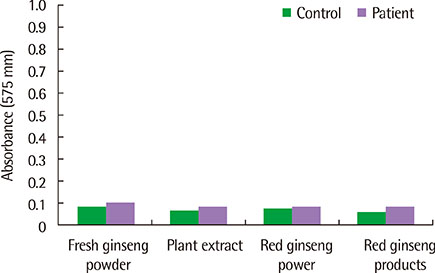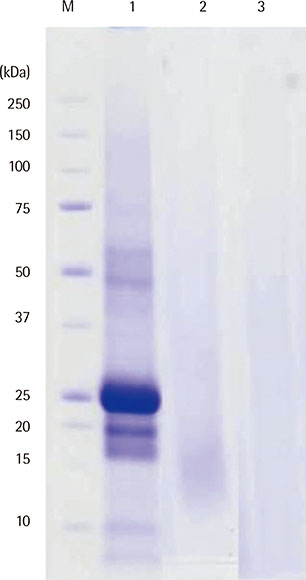Allergy Asthma Respir Dis.
2015 May;3(3):219-223. 10.4168/aard.2015.3.3.219.
Mixed plant extract-dependent exercise-induced anaphylaxis
- Affiliations
-
- 1Department of Pediatrics, Samsung Medical Center, Sungkyunkwan University School of Medicine, Seoul, Korea. jhlovechild@gmail.com
- 2Environmental Health Center for Atopic Diseases, Samsung Medical Center, Seoul, Korea.
- KMID: 2168493
- DOI: http://doi.org/10.4168/aard.2015.3.3.219
Abstract
- Food-dependent exercise-induced anaphylaxis (FDEIA) is a potentially life-threatening clinical reaction in which anaphylaxis develops when physical activity occurs within a few hours after ingesting a specific food. An 18-year-old girl experienced generalized urticaria, periorbital swelling, and dyspnea repeatedly by exercise after intake of a red ginseng health supplement. A confirmed diagnosis was established in this case by using an exercise challenge test after ingesting mixed-plant extract containing red ginseng health supplement. To the best of our knowledge, this is the first case of FDEIA caused by components in a red ginseng health supplement.
Keyword
Figure
Cited by 1 articles
-
The past, present, and future of research on anaphylaxis in Korean children
Sooyoung Lee
Allergy Asthma Respir Dis. 2018;6(Suppl 1):S21-S30. doi: 10.4168/aard.2018.6.S1.S21.
Reference
-
1. Sharma R, Sinha R, Menon PS, Sirohi D. Management protocol for anaphylaxis. J Oral Maxillofac Surg. 2010; 68:855–862.
Article2. Radlińska A, Barg W, Wolanczyk-Medrala A, Medrala W. Food-dependent exercise-induced anaphylaxis: current concepts in pathogenesis, diagnostics and treatment. Pol Merkur Lekarski. 2011; 30:49–51.3. Du Toit G. Food-dependent exercise-induced anaphylaxis in childhood. Pediatr Allergy Immunol. 2007; 18:455–463.
Article4. Kiefer D, Pantuso T. Panax ginseng. Am Fam Physician. 2003; 68:1539–1542.5. Kim YK, Oh SY, Jung JW, Min KU, Kim YY, Cho SH. IgE binding components in Tetranychus urticae and Panonychus ulmi-derived crude extracts and their cross-reactivity with domestic mites. Clin Exp Allergy. 2001; 31:1457–1463.
Article6. Lee JY, Jin HJ, Park JW, Jung SK, Jang JY, Park HS. A case of korean ginseng-induced anaphylaxis confirmed by open oral challenge and basophil activation test. Allergy Asthma Immunol Res. 2012; 4:110–111.
Article7. Maulitz RM, Pratt DS, Schocket AL. Exercise-induced anaphylactic reaction to shellfish. J Allergy Clin Immunol. 1979; 63:433–434.
Article8. Sheffer AL, Tong AK, Murphy GF, Lewis RA, McFadden ER Jr, Austen KF. Exercise-induced anaphylaxis: a serious form of physical allergy associated with mast cell degranulation. J Allergy Clin Immunol. 1985; 75:479–484.
Article9. Matsuo H, Morimoto K, Akaki T, Kaneko S, Kusatake K, Kuroda T, et al. Exercise and aspirin increase levels of circulating gliadin peptides in patients with wheat-dependent exercise-induced anaphylaxis. Clin Exp Allergy. 2005; 35:461–466.
Article10. Qamar MI, Read AE. Effects of exercise on mesenteric blood flow in man. Gut. 1987; 28:583–587.
Article11. Cheng CX, Li YN, Ohno H, Sawanobori K, Li YC, Shimada O, et al. Mast cells appearing in long-term skeletal muscle cell cultures of rat. Anat Rec (Hoboken). 2007; 290:1424–1430.
Article12. Wolanczyk-Medrala A, Barg W, Gogolewski G, Panaszek B, Liebhart J, Litwa M, et al. Influence of hyperosmotic conditions on basophil CD203c upregulation in patients with food-dependent exercise-induced anaphylaxis. Ann Agric Environ Med. 2009; 16:301–304.13. Katsunuma T, Iikura Y, Akasawa A, Iwasaki A, Hashimoto K, Akimoto K. Wheat-dependent exercise-induced anaphylaxis: inhibition by sodium bicarbonate. Ann Allergy. 1992; 68:184–188.14. Palosuo K, Varjonen E, Nurkkala J, Kalkkinen N, Harvima R, Reunala T, et al. Transglutaminase-mediated cross-linking of a peptic fraction of omega-5 gliadin enhances IgE reactivity in wheat-dependent, exercise-induced anaphylaxis. J Allergy Clin Immunol. 2003; 111:1386–1392.
Article15. Pedersen BK, Steensberg A, Schjerling P. Exercise and interleukin-6. Curr Opin Hematol. 2001; 8:137–141.
Article16. Morita E, Kunie K, Matsuo H. Food-dependent exercise-induced anaphylaxis. J Dermatol Sci. 2007; 47:109–117.
Article17. Kleiman J, Ben-Shoshan M. Food-dependent exercise-induced anaphylaxis with negative allergy testing. BMJ Case Rep. 2014; 02. 06. [E-pub] http://dx.doi.org/10.1136/bcr-2013-202057.
Article18. Oh JW. Food additives and allergic diseases in childhood. Hanyang Med Rev. 2011; 31:261–268.
Article19. Hawkes C. Nutrition labels and health claims: the global regulatory environment. Geneva: World Health Organization;2004.20. Sanz ML, Gamboa PM, De Weck AL. In vitro tests: basophil activation tests. In : Pichler WJ, editor. Drug hypersensitivity. Basel: Karger;2007. p. 391–402.
- Full Text Links
- Actions
-
Cited
- CITED
-
- Close
- Share
- Similar articles
-
- A case of parsely dependent sxercise-induced anaphylaxsis
- A Case of Wheat-Dependent Exercise-Induced Anaphylaxis
- Wheat-dependent, Exercise-induced Anaphylaxis: A Successful Case of Prevention with Ketotifen
- Food allergies and food-induced anaphylaxis: role of cofactors
- Three Cases of Food-dependent Exercise-induced Anaphylaxis



